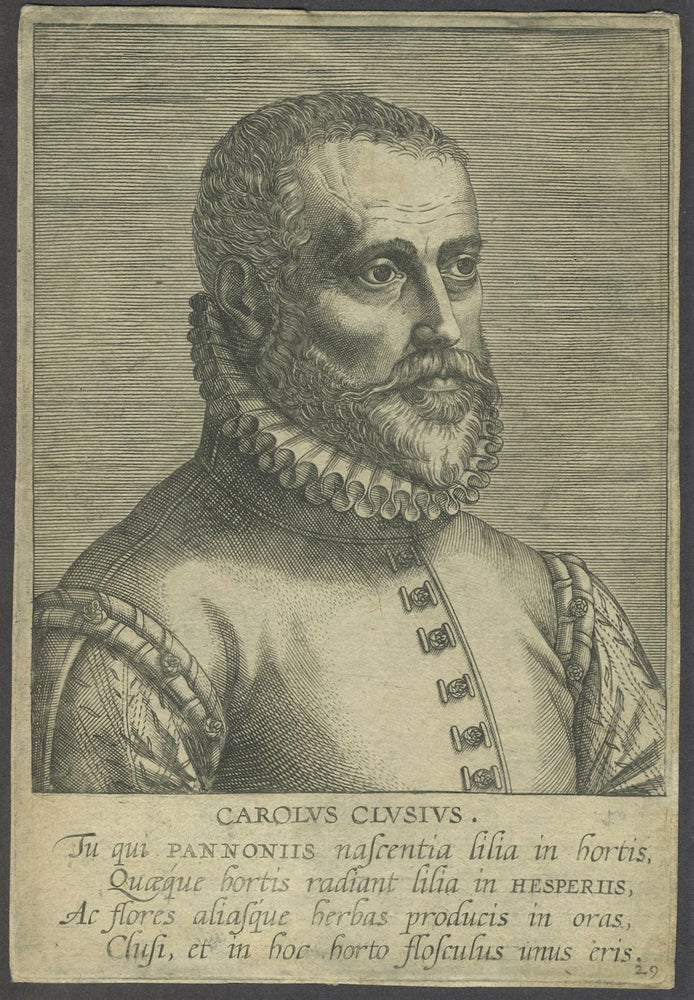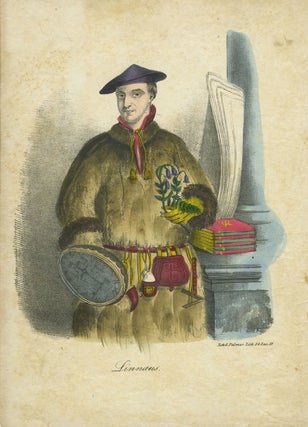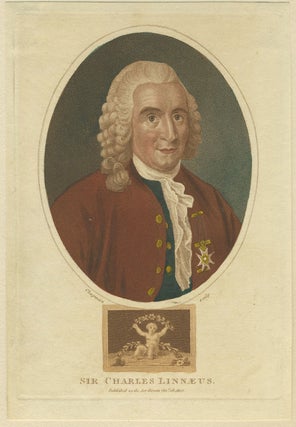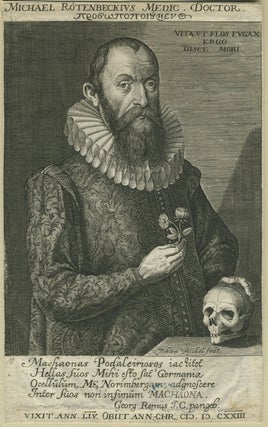Portraits of the Founding Fathers of Botanical Study.
1600-1850. An archive of 26 portraits of the founding fathers of botany, including Dodoens, Leeuwenhoek, Grew, Hill, Aldrovandi, Smith, Desfontaines, Palisot, Gessner, Everard, Bonnet, Banks, Buffon, Gray, Evelyn, Linnaeus, Cuvier, Klein, Clusius, and Agassiz.
1. Rembert Dodoens (born Rembert Van Joenckema, 1517 – 1585) was a Flemish physician and botanist. Rembert Dodoens (Rembertus Dodonaeus) was one of the great botanists of the 16th century who pursued a knowledge of plants in their own right, not simply for medicinal uses. Contemporary copper engraving, 4 7/8 x 7" on 7 3/8 x 10 1/2".
2. Antonius Leeuwenhoek (1632 - 1723), Dutch "Father of Microbiology" with botanical importance, who worked with William III of Orange and his wife, Mary II of England, and Tsar Peter the Great of Russia. Copper engraving, 5 1/2 x 7 1/8".
3. Nehemiah Grew (1641 – 1712) was an English plant anatomist and physiologist, known as the "Father of Plant Anatomy". Copper engraving, 5 3/4 x 9 1/4".
4. John Hill (ca. 1714 – 1775), was an English author and botanist who contributed to contemporary periodicals including the botanical compendium 'The Vegetable System'. Copper engraving, 8 7/8 x 11 1/4" on 9 5/8 x 12 1/2".
5. Ulisse Aldrovandi (1522 – 1605) was an Italian naturalist, professor of botany, and one of the founders of the Bologna's botanical garden, one of the first in Europe. Carl Linnaeus and the Comte de Buffon considered Aldrovandi the father of natural history studies. 5 7/8 x 8 3/8".
6. Sir James Edward Smith (1759 – 1828) was an English botanist and founder of the Linnean Society, 5 x 7" on 8 7/8 x 11 5/8".
7. Rene Louiche Desfontaines (1750 – 1833) was a French botanist who studied medicine. His interest in botany originated from lectures given by Louis Guillaume Lemonnier at the Jardin des Plantes, 9 1/4 x 12 1/4".
8. Charles-François Brisseau de Mirbel (1776 – 1854) was a French botanist and politician. He was a founder of the science of plant cytology, 9 1/2 x 12 1/2".
9. Ambroise Marie François Joseph Palisot, Baron de Beauvois (1752 - 1820, Paris) was a French naturalist who was trained as a botanist, and published an important paper on American entomology, 9 x 12".
10. Antoine Laurent de Jussieu (1748 – 1836) was a French botanist, notably the first to publish a natural classification of flowering plants; his system remains largely in use today, 9 1/2 x 12 1/2".
11. Conrad Gessner (1516 – 1565) was a Swiss physician and naturalist, regarded as the father of modern scientific bibliography, zoology and botany. Gessner was working on a major botanical text at the time of his early death from the plague, 3 5/8 x 5 1/8" on 6 1/8 x 7 7/8".
12. Michael Rotenbeck (1569 - 1623) physician and collector of botanical works. Copper engraving, 7 5/8 x 4 3/4" on 13 x 8 1/2".
13. Dr. Giles Everard or Gilles Everaerts (16th century; active in 1580s), Dutch physician who wrote works on the beneficial medicinal effects of tobacco smoking. Copper engraving, 4 7/8 x 6" on 8 1/2 x 10".
14. Charles Bonnet (1720 – 1793), Naturalist and philosophical writer. He coined the term phyllotaxis to describe the arrangement of leaves on a plant. 8 1/2 x 12 1/2".
15. Georges-Louis Leclerc, Comte de Buffon (1707 – 1788) was a French naturalist, mathematician, cosmologist, and encyclopediste. Buffon was the director at the Jardin du Roi, now called the Jardin des Plantes. Buffon published 36 quarto volumes of his 'Histoire Naturelle' during his lifetime. Ernst Mayr wrote that "Truly, Buffon was the father of all thought in natural history in the second half of the 18th century". 4 1/2 x 6 3/8" on 9 x 11 1/2".
16. Sir Joseph Banks, 1st Baronet, GCB, PRS (1743 – 1820), English naturalist, botanist and patron of the natural sciences. 7 x 10 3/8".
17. Asa Gray (1810 – 1888) is considered the most important American botanist of the 19th century. His Darwiniana was significant as an explanation of how religion and science were not necessarily mutually exclusive. Gray was convinced that a genetic connection existed between all members of a species. He was opposed to the idea of hybridization within one generation and believed evolution was guided by a Creator. 6 x 8 5/8".
18. John Evelyn (1620 - 1706), author and botanist noted for his knowledge of trees. Evelyn's treatise, Sylva, or A Discourse of Forest-Trees (1664), was written as an encouragement to landowners to plant trees to provide timber for the English navy. 8 x 10".
19. Carl Linnaeus (1707 – 1778), (Carl von Linne), was a Swedish botanist, physician, and zoologist who formalized binomial nomenclature, the modern system of naming organisms. (6 images: 4 1/2 x 6 1/2", 6 x 8 1/2", 4 7/8 x 8, 5 1/2 x 9", 7 x 10 1/2", 6 1/4 x 8 1/2").
20. Jean Leopold Nicolas Frederic, Baron Cuvier (1769 – 1832), known as Georges Cuvier, was a French naturalist and zoologist, instrumental in establishing the fields of comparative anatomy and paleontology through his work in comparing living animals with fossils. (4 images: 5 x 8 1/4", 6 3/4 x 9 7/8", 6 x 9", 7 1/2 x 10").
21. Jacob Theodor Klein (1685 – 1759) was a German jurist, historian, botanist, zoologist, mathematician and diplomat in service of Polish King August II the Strong. 9 x 14 5/8" on 9 1/2 x 15 1/2".
22. Charles de l'Ecluse, L'Escluse, or Carolus Clusius (1526 – 1609), was an Artois doctor and pioneering botanist, perhaps the most influential of all 16th-century scientific horticulturists. 4 5/8 x 6 5/8".
23. Jean Louis Rodolphe Agassiz (1807 – 1873) was a Swiss-American biologist and geologist recognized as an innovative and prodigious scholar of Earth's natural history. 9 1/4 x 12 1/4".
24. John Lindley (1799 - 1865), English botanist and orchidologist, whose orchid collection was housed at Kew's herbarium, noted for his 'Theory and Practice of Horticulture'.
25. Joseph Decaise (1807 - 1882), French botanist and agronomist. 5 1/2 x 8 3/4".
26. Louis Van Houtte (1810 -1876). Belgian horticulturist. Published the "Journal Flore des Serres et des Jardins de l'Europe". 5 1/2 x 8 3/4".
The portraits mainly steel engraved, some lithographic, mostly 4to. All in very good condition. Very good condition. Item #24734
Price: $750.00






